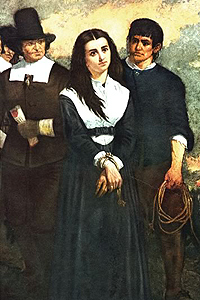Week 2, Meeting 1
Topics:
Introduction to the Salem Witchcraft trials
What the sources say
Readings:
Browse the Salem Witch Trials Documentary Archive and Transcription Project
In-class Activity:
Come to class prepared to discuss what you found.
Week 2, Meeting 2
Topics:
Exploring Salem online
Readings:
The Examination of Rebecca Nurse
The Examination of Mary Osgood
Assignment:
Take notes (and bring them to class) on what strikes you as interesting about these two examinations. What are the differences between them? How are they similar? We will discuss your notes in class.
Week 3, Meeting 1
Topics:
The Devil and Woman in Puritan New England
Readings:
Blood on Her Hands, Chapter 4, pp 58-82.
Elizabeth Reis, “The Devil, the Body, and the Feminine Soul in Puritan New England,” The Journal of American History, Vol. 82, No. 1 (Jun., 1995), pp. 15-36.
In-class Activity:
Discussion
Week 3, Meeting 2
Topics:
Multicultural influences on the colonists in New England
Constructs of ‘Other’ in New England
Readings:
Review the case file for Tituba
Elaine G. Breslaw, “Tituba’s Confession: The Multicultural Dimensions of the 1692 Salem Witch-Hunt,” Ethnohistory, Vol. 44, No. 3 (Summer, 1997), pp. 535-556.
Assignments:
Given all the evidence you’ve read on the witch trials in Salem so far, write 200-300 words and make an argument about how women shaped the course of these trials. Please use the examinations and case files and/or the secondary readings to support your argument.
Week 4, Meeting 1
Topics:
How have historians studied the witch trials
Differing arguments about the underlying causes: economics, geographical, political
Readings:
Benjamin C. Ray, “The Geography of Witchcraft Accusations in 1692 Salem Village,” The William and Mary Quarterly, Third Series, Vol. 65, No. 3 (Jul., 2008), pp. 449-478.
Paul Boyer and Stephen Nissenbaum, “Salem Possessed” in Retrospect, The William and Mary Quarterly, Third Series, Vol. 65, No. 3 (Jul., 2008), pp. 503-534.
Activity:
Discuss Ray’s critique and re-evaluation of the geo-spatial information that helps him formulate his own reading of the trials.
Discuss Boyer and Nissenbaum’s reflection on their own work as a window into how historians do what they do–how they use evidence.
Week 4, Meeting 2
Topics:
How historians have studied the trials, continued.
Readings:
Mary Beth Norton, “Witchcraft in the Anglo-American Colonies,” OAH Magazine of History, Vol. 17, No. 4, Witchcraft (Jul., 2003), pp. 5-10.
Assignments:
Review the Salem Witch Trials page on Wikipedia. Based on everything we have learned about the trials, please take notes (and bring them to class) reflecting your evaluation of the entry, noting its relative strengths and weaknesses. For example you may choose to address, how well the entry reflects the current debate among historians about the reasons behind the trials. You may choose to address how women are represented or if there is significant discussion of the gender issues inherent in the trials and its aftermath. Please comment on what would you change about the entry and why? We will discuss these in class.
